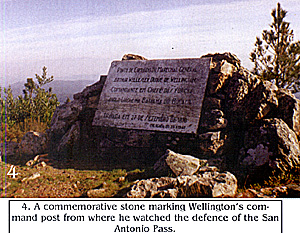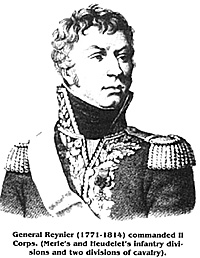Leith arrived at the Pass as Foy's attack was developing. From the start of their
climb the French had endured heavy salvos from Arentschildt's guns, but they continued quickly
up the hillside "receiving all and giving nothing." [28]
With Leith was a battery of 6-pounders which Leith dropped off at the Pass to help
Arentschildt whose guns were running out of ammunition. He also left behind at the Pass Spry's
Portuguese brigade and his two battalions of the Lusitanian Legion to support Mackinnon. Leith continued with his British brigade and announced his arrival to Picton, at this moment Major-General Leith's aide-de-camp came up to report the arrival of that general and his division, on which I rode from the post of San Antonio to the road of communication, and directed the leading regiment of the brigade to proceed without loss of time to the left, as I had no occasion for
assistance." Wrote Picton. "General Leith's brigade in consequence, moved on and arrived in time to join the rive companies of the 45th and the 8th Portuguese repulsing the enemy's last attempt." [29]
When Leith arrived he saw that a "heavy fire of musketry was being kept up upon the heights, the smoke of which prevented a clear view of the state of things." He later wrote. -But when the rock forming the high point of the Serra became visible, the enemy appeared to be in full possession of it... and along the whole face of the slope of the Serra, in a diagonal direction towards its bottom, bythe enemy ascending rapidly in successive columns, formed for an attack upon a mass of men belonging to the left battalion of the 8th and the 9th Portuguese which had been rushed from the Pass to support its sister battalion." [30]
Foy had managed
to force his way almost to the summit. The Thomar
Militia had broken and fled at the first volley but the
other Portuguese regiments stood their ground and
forced Foy to swerve to his right where the crest was
unoccupied. "We had not moved fifty paces before we
found ourselves engaged with a French column moving
up the hill," reported Colonel Douglas of the 8th
Portuguese, -who finding themselves opposed in front
and seeking ammoccupfed interval on our left, discon-
tinued their attack on us and by a flank movement
gained the crest of the position on the left." [31] This flank
march enabled the head of Foy's column to actually reach the plateau.
Leith deployed his leading battalion, the 9th
British Regiment, across the summit of the plateau and
sent his second battalion, the 38th Regiment, to the
reverse side of the mountain so that Foy's column could
be assailed head on. The 38th found that the western
slope of the ridge was so densely covered with large
boulders that they were unable to climb it. Nevertheless
Leith had led the 9th British diagonally across the
plateau so as to place it along the flank of Foy's leading
battalions. The 9th, supportedby the 74th and some of
the 8th and 9th Portuguese which had rallied and reformed, opened with a volley at 100 yards and advanced
firing against the exposed flank of the 17th Leger. The
38th returned from their unsuccessful attempt on the
western slope and took up position on the right of the
9th, and Arentschildt's guns added their weight to the
onslaught. "The ground was covered with dead and
dying, not new levies or mercenaries but the elite of the
French army." [32]
Foy's horse was shot from under him but he was unhurt and he quickly mounted the horse of
an aide-de-camp and, now hatless, he cheered his men on up the slope. "My heroic column, much diminished during the ascent, reached the summit of the plateau, which was covered with hostile troops." Reported Foy. "Those on our left made a flank movement and smashed us up by their battalion volleys, meanwhile those on our front, covered by some rocks, were murdering us with impunity. The head of my column fell back to its light, despite my efforts, I could not get them to deploy, disorder set in, and the l7th and 70th raced down-hill in headlong flight. The enemy pursued us half-way to the front of the heights, till he pulled up on coming under effective fire from our artillery." [33]
Foy was wounded in the arm and carried back by his men down the hillside as they ran. Some of Foy's men had actually succeeded in crossing the communication road at the rear of the summit and these were left stranded by Foy's flight. A few managed to surrender but most of them were killed.
Reynier had only one regiment that had not been engaged -- the four battalions of the 47th Line -- left in reserve, all the other twenty-two battalions had been badly beaten.
The attack on the San Antonio Pass was clearly over. The 2nd Corps had lost over 2,000 men
including more than half its senior officers. General Graindorge had been killed, and General's Merle and Foy were both wounded. Colonel's Desgraviers of the 4th Leger, Merle of the 2nd Leger, Meunier of the 31st Leger and Lavigne of the 70th Line had also been wounded, and of the twenty-three battalion commanders that had marched up the mountain, four had been killed and seven wounded. Of the 421 officers in total that went into action, 118 had been hit.
Wellington was left with little alternative but to retreat. But this he did without regret for behind him were the formidable defences of the Lines of Torres Vedras, which his army reached four days ahead of the French. The heavy defeat at Bussaco had had a profound effect upon the French and Massena would not compromise the army of His Majesty" [34] by attacking Wellington again in a strong position.
Massena was forced to withdraw from before the Lines and eventually he retired over the border back into Spain. "The retreat that began... on the night of Nov. 14, 1810," Oman wrote a century later, "was to end at Toulouse on April 11, 1814." [35]
But if Reynier had captured the San Antonio Pass, Wellington would never have been able to retreat safely from the mountain. The reverse slope of the Serra is steep and difficult and an
orderly withdrawal would have been impossible and a secure occupation of the Lines of Torres Vedras highly improbable, "and our army," wrote one of Massena's officers, "in full strength and ardour, would have attacked the Lines on its arrival, and certainly have carried them." [36]
Wellington would have been compelled to evacuate Portugal. "It was at Lisbon that the fate of the Feninsula was to be decided," recorded another French Officer, "if the British were forced to abandon the capital they would lose all their influence in Spain... Fortugal would submit and Spain, exhausted and discouraged, would follow its example as soon as it was abandoned."
[37]
Thus would have ended the Peninsular War.
[1] Oman,C. A History of the Peninsular War, vol 3 p. v
More San Antonio Pass
 Similarly Hill had been ordered to occupy the ground that would be vacated by the 5th Division.
Walker galloped off to bring over the 2nd Division but Leith's men were already on their way,
marching "by the road of communication in the rear of and nearly parrallei to the ridge of the Serra, till it should appear where their support might
be necessary." [27]
Similarly Hill had been ordered to occupy the ground that would be vacated by the 5th Division.
Walker galloped off to bring over the 2nd Division but Leith's men were already on their way,
marching "by the road of communication in the rear of and nearly parrallei to the ridge of the Serra, till it should appear where their support might
be necessary." [27]
 Despite Reynier's failure Marshall Ney attempted to force the northern sector of the Allied line but he too met defeat, suffering almost 2,500 casualties. There was obviously nothing to be gained by ordering his tired and demoralised troops to attack the heights again, and so Massena instructed his cavalry to find a way round Wellington's position. At approximately noon the following day Massena's scouts returned to headquarters to report that such a route had been found to the north through Sardao and onto the main Oporto to Coimbra highway. Before nightfall the bulk of L'Armee de Portugal was marching away from the foot of the Serra de Bussaco.
Despite Reynier's failure Marshall Ney attempted to force the northern sector of the Allied line but he too met defeat, suffering almost 2,500 casualties. There was obviously nothing to be gained by ordering his tired and demoralised troops to attack the heights again, and so Massena instructed his cavalry to find a way round Wellington's position. At approximately noon the following day Massena's scouts returned to headquarters to report that such a route had been found to the north through Sardao and onto the main Oporto to Coimbra highway. Before nightfall the bulk of L'Armee de Portugal was marching away from the foot of the Serra de Bussaco.
NOTES
[2] Wellington, A. Supplementary Dispatches etc. of Meld Marshall Arthur Duke of Wellington, vol vi p.423
[3] Gurwood, J. The Dispatches of Field Marshal the Duke of Wellington, vol 4 p.261
[4] Dispatches, vol 6 pp. 6-7
[5] Dispatches, vol 6 pp. 495
[6] Dispatches, vol 6 p. 89
[7] Dispatches, vol 5 pp. 457-458
[8] Wellington to Lord Liverpool, September 21 18 10.
[9] The Peninsular Journal of Major General Sir Benjamin d'Urban, p.
148
[10] Grattan, W. Adventures with the Connaught Rangers, pp. 28-29
[11] Sherer, M. Recollections of the Peninsula, pp. 167-8
[12] Massena to Reynier, 26 September 1810 in Bonnal, vol III p. 388;
cited in Oman vol 3 p.549
[13] Grattan, p. 39
[14] Captain Lane's diary, quoted in G. Chambers, Wellington's
Battlefield's illustrated, Bussaco, p.87
[15] Grattan, p. 32
[16] Grattan, p. 33
[17] Grattan, p. 34
[18] Grattan, p. 34
[19] Robinson, H. Memoirs of Lieutenant General Sir Thomas Picton
vol. I pp. 331-338
[20] Chambers, p. 217
[21] Grattan, p. 35
[22] Chambers, p. 67
[23] Chambers, p.59
[24] Oman, vol 3 p. 374
[25] Ibid
[26] Napier, W. History of the War in the Peninsula and in the South of France, vol v pp. 423-424
[27] Supplementary Diispatches, volvi p.636
[28] Chambers, p.75
[29] Picton, vol I pp.331-338
[30] Leith's report, quoted in Chambers, p.78
[31] Colonel Douglas' report, Chambers, p.76
[32] Leith-Hay, A. A Narrative of the Peninsular War, vol i p. 164
[33] Foy, M. Vie Militaire du General Foy, p. 104
[34] Massena to Napoleon, quoted in Oman, vol 3 p.445
[35] Oman, vol 3 p.v
[36] Marbot, J. The memoirs of Baron de Marbot, p.433
[37] Pelet, J. The French Campaign in Portugal, p. 157
Back to Age of Napoleon 30 Table of Contents
Back to Age of Napoleon List of Issues
Back to MagWeb Master List of Magazines
© Copyright 1999 by Partizan Press.
This article appears in MagWeb (Magazine Web) on the Internet World Wide Web.
Other military history articles and gaming articles are available at http://www.magweb.com